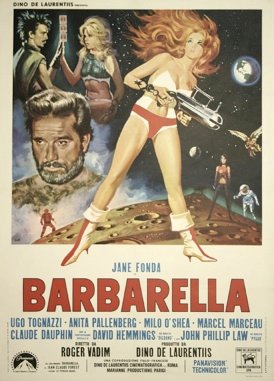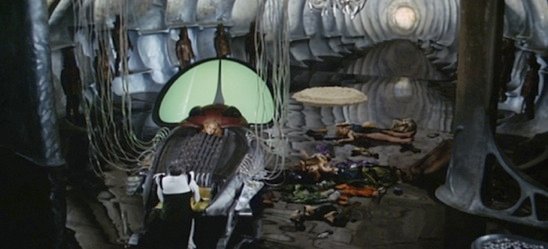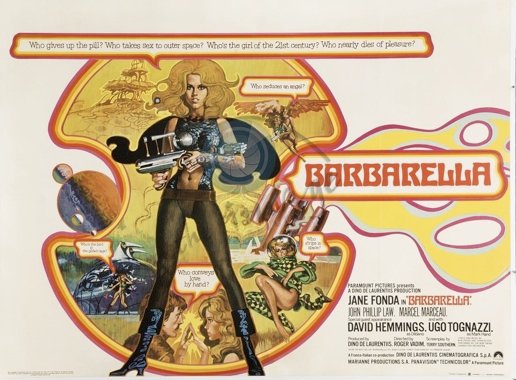
This afternoon I watched Barbarella, the 1968 Italio-Franco sci-fi standard starring Jane Fonda (for probably the fourth time of my life). I decided to view it through a Jungian lens (I just read "The Red Book"—mind stretching), watching the sets and props most keenly.
The movie is about the elemental feminine confronting nastier desires: aggression, unbridled lust, lethargy from sedative drugs. Barbarella is the only guileless character. And her body is equally innocent—41st century earth has somehow evolved beyond copulation, people take conception/bliss pills and hold hands in lieu of actual sex. I'm going to assume everyone reading this knows the plot, and skip right to a mostly Jungian interpretation. Here's a helpful passage from "Archetypes and the Collective Unconscious":
"Every man carries within him the eternal image of woman, not the image of this or that particular woman, but a definite feminine image. This image is fundamentally unconscious, an hereditary factor of primordial origin engraved in the living organic system of the man, an imprint or "archetype" of all the ancestral experiences of the female, a deposit, as it were, of all the impressions ever made by woman-in short, an inherited system of psychic adaptation. Even if no women existed, it would still be possible, at any given time, to deduce from this unconscious image exactly how a woman would have to be constituted psychically. The same is true of the woman: she too has her inborn image of man."
From the first shot, the feminine is called forth: a veiled spaceman floats in a soft, gold room, attached to its walls with long, slack cords. This is a womb. There's a statue of Isis holding a crescent moon and offering one of her breasts out of her dress. The androgynous astronaut takes off their suit, and a young Jane Fonda is revealed—she's like Venus inside a clamshell. But Barbarella's spaceship (seen from outside, it's a little model dangled from fishing line) is both masculine and feminine. Three phallic protrusions poke out from a playful pink vessel.
The first aliens on Tau Ceti (a cold but pretty planet) she encounters are twin girls, about eleven years old. They speak some strange language, throw an ice ball at her head, then drag her back to their lair of other prepubescent twins, via sled pulled by a flesh colored sting ray sort of creature, painfully fake, and not unlike an organ gliding across the ice. The bad children, who live in Alpha 1 (an abandoned spaceship) unleash a gang of killing dolls on Barbarella. The dolls have razors for teeth and walk of their own accord; painted blue, green, and sickly pale, they are a perversion of feminine energy. Twins carry weight in a lot of cultures; Jung read them as two separated halves of one whole, masculine and feminine, and sometimes, soul mates who've lost each other in the collective unconscious.
The hoard of evil dolls with snapping metal mouths may be the most disturbing scene in the whole movie: Barbarella is being consumed by malicious energy, eaten alive. She is rescued by a strapping Italian "Catchman" (Ugo Tognazzi), who wears a fur suit and teaches her all about coitus in his goofy mancave on ice. His name is Mark Hand, and he catches wayward children and delivers them to Sogo, the city of the night. Hand's bed is at the base of what's essentially a vaginal canal, a flesh colored fabric tube lit from within with a bearskin rug at the bottom. Here is where Barbarella learns of "old fashioned" lovemaking; in the 41st century the practice has been abandoned, long proven to be inefficient. When he takes off his fur suit, the Catchman's chest is equally furry; he's like a cartoon of a manly European. Even his ship is suggestive; its sail is a giant plastic clamshell, and the vessel drifts in lazy circles around an ice lake as they make love. Afterwards, a humming Barbella trades her shiny space suit for a fur suit, black and white with a long skunky tail. But two scenes later she's back to an S&M sailor suit (this film was made in 1968 in France; costumes were their own characters).
Next Barbarella meets Pygar (John Phillip Law, frequent guest at the Playboy Mansion in the '60s), a bronzed angel who lives in the labyrinth below Sogo. It's the labyrinth of the unconscious, where people peek out from inside rock walls and shrouds of spider webs. Bodies are half stuck into rocks, especially one couple who faces each other but is cemented waist deep into jagged rocks. Everyone here is naked except for fig leaf clothing fragments. "All that is not evil is exiled to the labyrinth" says the cooky professor who comes to fix Barbarella's ship. The labyrinth is the place where the psyche wanders unaware of itself, a monotonous, unrealized place that's intrinsically neither good nor bad. Like sleepwalkers, the people in the labyrinth have messy hair and touch each other without making eye contact. It's the psyche unable to connect with others, isolated in its own corner of the collective unconscious. And the slow moving labyrinth is the opposite pole of the city above, where any and all ruthless desires are played out: aggression, jealousy, addiction, and greed. The vulnerable parts of self are banished below, to wander disconnected in the unconscious.
Although he's an angel with giant floppy wings, Pygar can't fly until Barbarella seduces him in his bird's nest. Connection with the feminine enables the psyche to move freely again. They crash land into Sogo, where groups of girls make creepy eyes at them and men unabashedly stare. The naked psyche (a blind angel) isn't tolerated in Sogo; as soon as it's caught, it's crucified. Psyche, a Grecian beauty, was blindfolded with her lover Cupid until she couldn't stand not knowing what he looked like, lifted her veil, and ruined their union.
The sets and costumes in Sogo are all shiny surfaces: glass, plastic, leather. Reflective, manufactured textures. As Barbarella escapes from two ruffians with spiked collars and a threatening one-eyed lady with knives, she runs past a statue of an owl, the Grecian symbol of Athena. In other traditions, owls stood in for psychic ability and intuition.
Underneath Sogo is a lake of energy in liquid form that watches the citizens. The lake feeds on negative psychic vibrations; in return it gives light and warmth—but this light manifests in harsh colors, and the warmth rises up as menacing steam—"It has a terrible appetite" says Dr. Durand Durand, servant of the great tyrant and later, usurper of her throne. The name of this energy is Mathmos. The great tyrant (Anita Pallenberg) soon appears, with a horn on her head; she's evil, both masculine and feminine. Barbarella is dressed in all white, with curly blonde hair; the tyrant is in black, wearing a giant black wig and an unnerving plastic phallus.
A few scenes on, Durand Durand tries to pleasure Barbarella to death in a mechanical bed with an attached organ that he plays manically (the "excessive machine"). The machine eats her clothes and kind of looks like a dark jaw clamped around her body. It's a way of manipulating the senses. All of Sogo is like this; strange, PG sadomasochistic rites are performed and women smoke the essence of a man trapped in a glass jar. Evil is the perversion of someone's energy, for the consumption of others. Barbarella, pure feminine energy, beats the machine by wearing it out—her capacity for pleasure is unmatched in the universe. The excessive machine smokes and sputters out, and Barbarella emerges sweaty and pleased. Small wonder Penthouse called Barbarella "the kinkiest movie of the year" (though it wasn't successful at all in 1968; Paramount re-released it in 1977 with better marketing, and it found its footing as a cult classic).

The plot, which I have not made clear in any way (it's not all linear in the comic or the movie, frankly), wraps up when Barbarella finds a key into the chamber of dreams, intending to defeat the great tyrant who slumbers inside. The tyrant's dreams are magnified on the clear walls of the chamber, which is locked from the outside—this is how the unconscious is traveled, you get locked in from the outside. With the light and dark ladies trapped inside an impenetrable chamber, Dr. Durand Durand (and yes, the 80's band Duran Duran took their name from this character) explodes the city with his positronic ray and crowns himself lord. To fight off the rebels he releases Mathmos, pure evil—it consumes the entire city. But Barbarella's goodness shields herself and the tyrant from this evil, and Pygar flies them away. Barbarella asks him why he saved the tyrant after she crucified him, he says, "An angel has no memory." Likewise, the psyche has no memory when it's thrust into a dream—only certain clues and symbols serve as landmarks, and it can be hard to recognize these while we're down there in the collective unconscious.

I love this movie, great writing. A lot more sexist than Flash Gordon, but I love the costumes and the scenery in both :)
Downvoting a post can decrease pending rewards and make it less visible. Common reasons:
Submit
Thanks coinkingz. Sexism + sexy costumes in both, agreed. Seems like you can only get one or the other in today's films...
Downvoting a post can decrease pending rewards and make it less visible. Common reasons:
Submit
Hi! I am a robot. I just upvoted you! I found similar content that readers might be interested in:
https://emvlovely.wordpress.com/2014/03/06/barbarella-jungian-style/
Downvoting a post can decrease pending rewards and make it less visible. Common reasons:
Submit
that is my blog cheetah, which I've kept since 2009. I don't know how to identify myself with both. Should I close my blog?
Downvoting a post can decrease pending rewards and make it less visible. Common reasons:
Submit
In other words, I wrote this article myself. Not a thief.
Downvoting a post can decrease pending rewards and make it less visible. Common reasons:
Submit